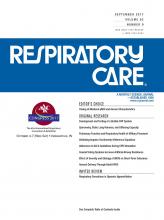Abstract
Dynamic hyperinflation is a common cause of dyspnea and functional limitation in patients with emphysema. Dynamic hyperinflation occurs in individuals with air-flow limitation when expiratory time is decreased during periods of relative tachypnea (such as during exercise or agitation, for example). In this setting, patients with emphysema develop lung hyperinflation, impairment of inspiratory respiratory muscles, and an increase in work of breathing. The associated decrease in inspiratory capacity results in the stimulation of several receptors, including chemoreceptors and pulmonary receptors, which signal the brain to increase tidal volume. The inability of the respiratory system to respond to signals of increased demand (eg, by enlarging tidal volume and increasing inspiratory flow) results in a dissociation between afferent and efferent signaling thereby intensifying breathing discomfort, or what clinicians term dyspnea. A thorough understanding of the physiology of dyspnea and pathophysiology of dynamic hyperinflation informs the interventions used to mitigate sensations of dyspnea and the physiologic effects of dynamic hyperinflation, respectively. Pharmacotherapy, pulmonary rehabilitation, breathing techniques, positive airway pressure, and lung volume reduction are well-studied interventions that target pathways to dyspnea in patients with dynamic hyperinflation.
- dynamic hyperinflation
- air-flow limitation
- dyspnea
- inspiratory threshold load
- inspiratory capacity
- neuroventilatory dissociation
Footnotes
- Correspondence: Morgan I Soffler MD, Carl J. Shapiro Institute for Education and Research, Beth Israel Deaconess Medical Center, 330 Brookline Avenue Boston, MA 02215. E-mail: msoffler{at}bidmc.harvard.edu.
The authors have disclosed no conflicts of interest.
- Copyright © 2017 by Daedalus Enterprises







